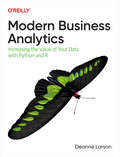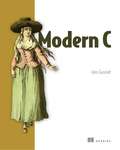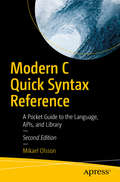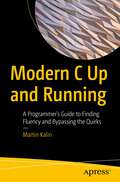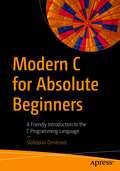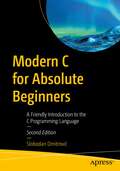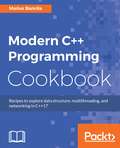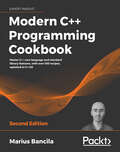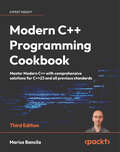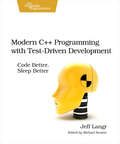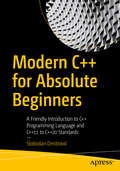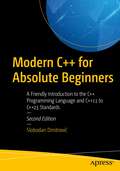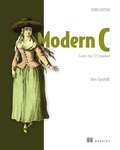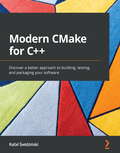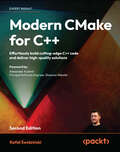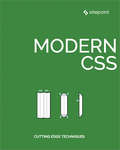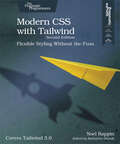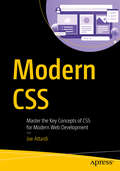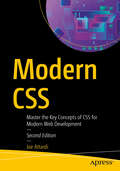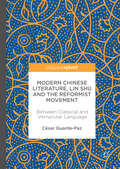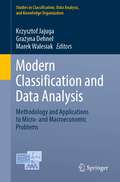- Table View
- List View
Modern Business Analytics: Increasing the Value of Your Data with Python and R
by Deanne LarsonDeriving business value from analytics is a challenging process. Turning data into information requires a business analyst who is adept at multiple technologies including databases, programming tools, and commercial analytics tools. This practical guide shows programmers who understand analysis concepts how to build the skills necessary to achieve business value.Author Deanne Larson, data science practitioner and academic, helps you bridge the technical and business worlds to meet these requirements. You'll focus on developing these skills with R and Python using real-world examples. You'll also learn how to leverage methodologies for successful delivery. Learning methodology combined with open source tools is key to delivering successful business analytics and value.This book shows you how to:Apply business analytics methodologies to achieve successful resultsCleanse and transform data using R and PythonUse R and Python to complete exploratory data analysisCreate predictive models to solve business problems in R and PythonUse Python, R, and business analytics tools to handle large volumes of dataCommit code to GitHub to collaborate with data engineers and data scientistsMeasure success in business analytics
Modern C
by Jens GustedtIf you think "Modern" and "C" don't belong in the same sentence, think again. The C standards committee actively reviews and extends the language, with updated published C standards as recently as 2018. In Modern C, author Jens Gustedt teaches you the skills and features you need to write relevant programs in this tried-and-true language, including Linux and Windows, device drivers, web servers and browsers, smartphones, and much more! Modern C teaches you to take your C programming skills to new heights, whether you're just starting out with C or have more extensive experience. Organized by level, this comprehensive guide lets you jump in where it suits you best while still reaping the maximum benefits. Purchase of the print book includes a free eBook in PDF, Kindle, and ePub formats from Manning Publications.
Modern C Programming: Including Standards C99, C11, C17, C23
by Orhan GaziThis book provides comprehensive detail about modern C programming, including the standards C99, C11, C17, C23, reflecting recent updates. The book features a number of targeted examples, atomic data types, and threads. After covering the standards of C, the author explains data types, operators, loops, conditional statements, functions, pointers, and more. The book is intended primarily for electrical and hardware engineers looking to use or update their knowledge of modern C programming.
Modern C Quick Syntax Reference: A Pocket Guide to the Language, APIs, and Library
by Mikael OlssonDiscover how C's efficiency makes it a popular choice in a wide variety of applications and operating systems with special applicability to wearables, game programming, system level programming, embedded device/firmware programming and in Arduino and related electronics hobbies in this condensed code and syntax guide. This book presents the essential C syntax in a well-organized format that can be used as a quick and handy reference. In this book, you will find short, simple, and focused code examples; and a well laid out table of contents and a comprehensive index allowing easy review. You won’t find any technical jargon, bloated samples, drawn out history lessons, or witty stories. What you will find is a language reference that is concise, to the point and highly accessible. The book is packed with useful information and is a must-have for any C programmer. What You Will Learn Code for some of today's modern and popular firmware and systems How to do embedded programming found in Arduino and related hardware boards Program microcontrollers for robots and boards Handle low-level programming and memory management Leverage operating systems such as Linux and Unix Who This Book Is For Those with experience in programming, particularly C programming, looking for a quick, handy reference.
Modern C Up and Running: A Programmer's Guide to Finding Fluency and Bypassing the Quirks
by Martin KalinLearn how to program in modern C, from the basics through the advanced topics required for proficiency. This book is the fastest path to C fluency for anyone experienced in a general-purpose programming language. From start to finish, code examples highlight the idioms and best practices behind efficient, robust programs in a variety of areas.The book opens with a thorough coverage of syntax, built-in data types and operations, and program structure. C has quirks and presents challenges, which are covered in detail. The coverage of advanced features is what sets this book apart from others. Among the advanced topics covered are floating-point representation in the IEEE 754 standard; embedded assembly language in C code for overflow detection; regular expressions, assertions, and internationalization; WebAssembly through C; and software libraries for C and other clients. Memory efficiency and safety are the two major challenges in C programming, and you’ll explore these challenges through a series of C examples. Arrays and structures, which are the means to high-level data representation, are covered in connection with pointers, which provide efficiency. The book again uses code examples in covering networking and wire-level security; concurrency (multiprocessing and multithreading); instruction-level parallelism; and interprocess communication through shared memory and files, pipes, message queues, and signals. Many books introduce C, but few also explain how to use it properly and optimally. Essential C does just that.What You'll LearnAccelerate your path to C mastery with this book for experienced programmersRefresh your approach to program structure and data typesDive into aggregates and pointers using modern C languageRevisit storage classes and scopeDive into concurrency (multiprocessing and multithreading) and instruction-level parallelismFinish with regular expressions, assertions, signals, locales and more Who This Book Is For Professional programmers or software developers who has prior experience with C or in general wanting an accelerated learning guide to modern C programming language.
Modern C for Absolute Beginners: A Friendly Introduction to the C Programming Language
by Slobodan DmitrovićLearn the C programming language easily and in a straightforward way. This book teaches the basics of C, the C Standard Library, and modern C standards. No previous programming experience is required.C is a language that is as popular today as it was decades ago. C covers a wide variety of domains. It can be used to program a microcontroller, or to develop an entire operating system. This book is an effort to introduce the reader to the C programming language in a concise and easy to follow manner.The author takes you through the C programming language, the Standard Library, and the C standards basics. Each chapter is the right balance of theory and code examples. After reading and using this book, you'll have the essentials to start programming in modern C. What You Will LearnThe C programming language fundamentalsThe C Standard Library fundamentalsNew C Standards featuresThe basics of types, operators, statements, arrays, functions, and structsThe basics of pointers, memory allocation, and memory manipulationTake advantage of best practices in C Who This Book Is For Beginner or novice programmers who wish to learn the C programming language. No prior programming experience is required.
Modern C for Absolute Beginners: A Friendly Introduction to the C Programming Language
by Slobodan DmitrovićLearn the basics of C, the C standard library, and modern C standards. Complete with modern, up-to-date examples and screenshots, this new edition is fully updated and reworked with the latest C23 standards and features. C is a language that is as popular today as it was decades ago. It can be used to program a microcontroller or to develop an entire operating system. Author Slobodan Dmitrović takes you on a journey through the C programming language, the standard library, and the C standards basics. Each chapter is the right balance of theory and code examples. Written in a concise and easy-to-follow manner, this book will provide you all the essentials needed to start programming in modern C. What You Will LearnUnderstand C programming language and C standard library fundamentalsWork with new C standards featuresStudy the basics of types, operators, statements, arrays, functions, and structsReview the fundamentals of pointers, memory allocation, and memory manipulationTake advantage of best practices in CWho This Book Is For Beginner or novice programmers who wish to learn the C programming language. No prior programming experience is required.
Modern C++ Programming Cookbook
by Marius BancilaOver 100 recipes to help you overcome your difficulties with C++ programming and gain a deeper understanding of the working of modern C++ About This Book • Explore the most important language and library features of C++17, including containers, algorithms, regular expressions, threads, and more, • Get going with unit testing frameworks Boost.Test, Google Test and Catch, • Extend your C++ knowledge and take your development skills to new heights by making your applications fast, robust, and scalable. Who This Book Is For If you want to overcome difficult phases of development with C++ and leverage its features using modern programming practices, then this book is for you. The book is designed for both experienced C++ programmers as well as people with strong knowledge of OOP concepts. What You Will Learn • Get to know about the new core language features and the problems they were intended to solve • Understand the standard support for threading and concurrency and know how to put them on work for daily basic tasks • Leverage C++'s features to get increased robustness and performance • Explore the widely-used testing frameworks for C++ and implement various useful patterns and idioms • Work with various types of strings and look at the various aspects of compilation • Explore functions and callable objects with a focus on modern features • Leverage the standard library and work with containers, algorithms, and iterators • Use regular expressions for find and replace string operations • Take advantage of the new filesystem library to work with files and directories • Use the new utility additions to the standard library to solve common problems developers encounter including string_view, any , optional and variant types In Detail C++ is one of the most widely used programming languages. Fast, efficient, and flexible, it is used to solve many problems. The latest versions of C++ have seen programmers change the way they code, giving up on the old-fashioned C-style programming and adopting modern C++ instead. Beginning with the modern language features, each recipe addresses a specific problem, with a discussion that explains the solution and offers insight into how it works. You will learn major concepts about the core programming language as well as common tasks faced while building a wide variety of software. You will learn about concepts such as concurrency, performance, meta-programming, lambda expressions, regular expressions, testing, and many more in the form of recipes. These recipes will ensure you can make your applications robust and fast. By the end of the book, you will understand the newer aspects of C++11/14/17 and will be able to overcome tasks that are time-consuming or would break your stride while developing. Style and approach This book follows a recipe-based approach, with examples that will empower you to implement the core programming language features and explore the newer aspects of C++.
Modern C++ Programming Cookbook: Master C++ core language and standard library features, with over 100 recipes, updated to C++20
by Marius BancilaA pragmatic recipe book for acquiring a comprehensive understanding of the complexities and core fundamentals of C++ programmingKey FeaturesExplore the latest language and library features of C++20 such as modules, coroutines, concepts, and rangesShed new light on the core concepts in C++ programming, including functions, algorithms, threading, and concurrency, through practical self-contained recipesLeverage C++ features like smart pointers, move semantics, constexpr, and more for increased robustness and performanceBook DescriptionC++ has come a long way to be one of the most widely used general-purpose languages that is fast, efficient, and high-performance at its core. The updated second edition of Modern C++ Programming Cookbook addresses the latest features of C++20, such as modules, concepts, coroutines, and the many additions to the standard library, including ranges and text formatting. The book is organized in the form of practical recipes covering a wide range of problems faced by modern developers. The book also delves into the details of all the core concepts in modern C++ programming, such as functions and classes, iterators and algorithms, streams and the file system, threading and concurrency, smart pointers and move semantics, and many others. It goes into the performance aspects of programming in depth, teaching developers how to write fast and lean code with the help of best practices. Furthermore, the book explores useful patterns and delves into the implementation of many idioms, including pimpl, named parameter, and attorney-client, teaching techniques such as avoiding repetition with the factory pattern. There is also a chapter dedicated to unit testing, where you are introduced to three of the most widely used libraries for C++: Boost.Test, Google Test, and Catch2. By the end of the book, you will be able to effectively leverage the features and techniques of C++11/14/17/20 programming to enhance the performance, scalability, and efficiency of your applications.What you will learnUnderstand the new C++20 language and library features and the problems they solveBecome skilled at using the standard support for threading and concurrency for daily tasksLeverage the standard library and work with containers, algorithms, and iteratorsSolve text searching and replacement problems using regular expressionsWork with different types of strings and learn the various aspects of compilationTake advantage of the file system library to work with files and directoriesImplement various useful patterns and idiomsExplore the widely used testing frameworks for C++Who this book is forThe book is designed for entry- or medium-level C++ programmers who have a basic knowledge of C++ and want to master the language and become prolific modern C++ developers. Experienced C++ programmers can leverage this book to strengthen their command of C++ and find a good reference to many language and library features of C++11/14/17/20.
Modern C++ Programming Cookbook: Master C++ core language and standard library features, with over 100 recipes, updated to C++20, 2nd Edition
by Marius BancilaA pragmatic recipe book for acquiring a comprehensive understanding of the complexities and core fundamentals of C++ programming Key Features Explore the latest language and library features of C++20 such as modules, coroutines, concepts, and ranges Shed new light on the core concepts in C++ programming, including functions, algorithms, threading, and concurrency, through practical self-contained recipes Leverage C++ features like smart pointers, move semantics, constexpr, and more for increased robustness and performance Book Description C++ has come a long way to be one of the most widely used general-purpose languages that is fast, efficient, and high-performance at its core. The updated second edition of Modern C++ Programming Cookbook addresses the latest features of C++20, such as modules, concepts, coroutines, and the many additions to the standard library, including ranges and text formatting. The book is organized in the form of practical recipes covering a wide range of problems faced by modern developers. The book also delves into the details of all the core concepts in modern C++ programming, such as functions and classes, iterators and algorithms, streams and the file system, threading and concurrency, smart pointers and move semantics, and many others. It goes into the performance aspects of programming in depth, teaching developers how to write fast and lean code with the help of best practices. Furthermore, the book explores useful patterns and delves into the implementation of many idioms, including pimpl, named parameter, and attorney-client, teaching techniques such as avoiding repetition with the factory pattern. There is also a chapter dedicated to unit testing, where you are introduced to three of the most widely used libraries for C++: Boost.Test, Google Test, and Catch2. By the end of the book, you will be able to effectively leverage the features and techniques of C++11/14/17/20 programming to enhance the performance, scalability, and efficiency of your applications. What you will learn Understand the new C++20 language and library features and the problems they solve Become skilled at using the standard support for threading and concurrency for daily tasks Leverage the standard library and work with containers, algorithms, and iterators Solve text searching and replacement problems using regular expressions Work with different types of strings and learn the various aspects of compilation Take advantage of the file system library to work with files and directories Implement various useful patterns and idioms Explore the widely used testing frameworks for C++ Who this book is for The book is designed for entry- or medium-level C++ programmers who have a basic knowledge of C++ and want to master the language and become prolific modern C++ developers. Experienced C++ programmers can leverage this book to strengthen their command of C++ and find a good reference to many language and library features of C++11/14/17/20.
Modern C++ Programming Cookbook: Master Modern C++ with comprehensive solutions for C++23 and all previous standards
by Marius BancilaMeta Description: With a wealth of practical recipes, this third edition isn't just a guide to C++23; it's a complete resource covering key features and techniques from C++11 through to C++23. It's designed to keep you ahead of the curve in C++.Key FeaturesUpdated and packed with new recipes, including sync streams, std:expected and std:mdspan, and C++20/23 range adaptorsCovers all significant features from all modern versions of the standard, providing comprehensive insights into modern C++Learn through a series of hands-on, self-contained recipesPurchase of the print or Kindle book includes a free eBook in PDF formatBook DescriptionThe updated third edition of Modern C++ Programming Cookbook addresses the latest features of C++23, such as the stacktrace library, std::expected and std::mdspan classes, the header, formatting library improvements, and updates to the ranges library. It also gets into more C++20 topics not previously covered, such as sync streams and source_location. The book is organized into practical recipes covering a wide range of real-world problems, helping you find the solutions you need quickly. You’ll find coverage of all the core concepts of modern C++ programming and features and techniques from C++11 through to C++23, meaning you’ll stay ahead of the curve by learning to incorporate the newest language and library improvements. Beyond the core concepts and new features, you’ll explore recipes related to performance and best practices, how to implement useful patterns and idioms, like pimpl, named parameter, attorney-client, and the factory pattern, and how to complete unit testing with the widely used C++ libraries: Boost.Test, Google Test, and Catch2. With the comprehensive coverage this C++ programming guide offers, by the end of the book you’ll have everything you need to build performant, scalable, and efficient applications in C++. What you will learnExplore the new C++23 language and library featuresGo deep into the most useful C++20 featuresLearn to handle threading and concurrency for better performanceSolve complex string manipulation tasks efficiently with regexLeverage the standard library for faster developmentMaster the filesystem library to work with files and directoriesWork with different types of strings and understand compilationSee how you can use CRTP, mixins and other patterns in C++Who this book is forThis book is designed for entry- and intermediate-level programmers who already have a foundational understanding of the C++ programming language, but who are looking to master the language, implement the newest features, and become proficient modern C++ developers. Experienced C++ programmers can leverage the recipes in this book to quickly get up to speed on all the most important language and library features of C++11/14/17/20 and 23.
Modern C++ Programming with Test-Driven Development: Code Better, Sleep Better
by Jeff LangrIf you program in C++ you've been neglected. Test-driven development (TDD) is a modern software development practice that can dramatically reduce the number of defects in systems, produce more maintainable code, and give you the confidence to change your software to meet changing needs. But C++ programmers have been ignored by those promoting TDD--until now. In this book, Jeff Langr gives you hands-on lessons in the challenges and rewards of doing TDD in C++. Modern C++ Programming With Test-Driven Development, the only comprehensive treatment on TDD in C++ provides you with everything you need to know about TDD, and the challenges and benefits of implementing it in your C++ systems. Its many detailed code examples take you step-by-step from TDD basics to advanced concepts. As a veteran C++ programmer, you're already writing high-quality code, and you work hard to maintain code quality. It doesn't have to be that hard. In this book, you'll learn: how to use TDD to improve legacy C++ systemshow to identify and deal with troublesome system dependencieshow to do dependency injection, which is particularly tricky in C++how to use testing tools for C++ that aid TDDnew C++11 features that facilitate TDD As you grow in TDD mastery, you'll discover how to keep a massive C++ system from becoming a design mess over time, as well as particular C++ trouble spots to avoid. You'll find out how to prevent your tests from being a maintenance burden and how to think in TDD without giving up your hard-won C++ skills. Finally, you'll see how to grow and sustain TDD in your team. Whether you're a complete unit-testing novice or an experienced tester, this book will lead you to mastery of test-driven development in C++. What You Need A C++ compiler running under Windows or Linux, preferably one that supports C++11. Examples presented in the book were built under gcc 4.7.2.Google Mock 1.6 (downloadable for free; it contains Google Test as well) or an alternate C++ unit testing tool. Most examples in the book are written for Google Mock, but it isn't difficult to translate them to your tool of choice.A good programmer's editor or IDE.cmake, preferably. Of course, you can use your own preferred make too. CMakeLists.txt files are provided for each project. Examples provided were built using cmake version 2.8.9.Various freely-available third-party libraries are used as the basis for examples in the book. These include: cURLJsonCppBoost (filesystem, date_time/gregorian, algorithm, assign) Several examples use the boost headers/libraries. Only one example uses cURL and JsonCpp.
Modern C++ for Absolute Beginners: A Friendly Introduction to C++ Programming Language and C++11 to C++20 Standards
by Slobodan DmitrovićLearn the C++ programming language in a structured, straightforward, and friendly manner. This book teaches the basics of the modern C++ programming language, C++ Standard Library, and modern C++ standards. No previous programming experience is required. C++ is a language like no other, surprising in its complexity, yet wonderfully sleek and elegant in so many ways. It is also a language that cannot be learned by guessing, one that is easy to get wrong and challenging to get right. To overcome this, each section is filled with real-world examples that gradually increase in complexity. Modern C++ for Absolute Beginners teaches more than just programming in C++20. It provides a solid C++ foundation to build upon. The author takes you through the C++ programming language, the Standard Library, and the C++11 to C++20 standard basics. Each chapter is accompanied by the right amount of theory and plenty of source code examples. You will work with C++20 features and standards, yet you will also compare and take a look into previous versions of C++. You will do so with plenty of relevant source code examples. What You Will LearnWork with the basics of C++: types, operators, variables, constants, expressions, references, functions, classes, I/O, smart pointers, polymorphism, and more Set up the Visual Studio environment on Windows and GCC on Linux, where you can write your own codeDeclare and define functions, classes, and objects, and organize code into namespacesDiscover object-oriented programming: classes and objects, encapsulation, inheritance, polymorphism, and more using the most advanced C++ featuresEmploy best practices in organizing source code and controlling program workflowGet familiar with C++ language dos and donts, and moreMaster the basics of lambdas, inheritance, polymorphism, smart pointers, templates, modules, contracts, concepts, and more Who This Book Is For Beginner or novice programmers who wish to learn C++ programming. No prior programming experience is required.
Modern C++ for Absolute Beginners: A Friendly Introduction to the C++ Programming Language and C++11 to C++23 Standards
by Slobodan DmitrovićLearn the C++ programming language in a structured, straightforward, and friendly manner. This book teaches the basics of the modern C++ programming language, the C++ Standard Library, and modern C++ standards, including C++23. No previous programming experience is required. C++ is a language like no other, surprising in its complexity, yet wonderfully sleek and elegant in so many ways. It is also a language that cannot be learned by guessing, one that is easy to get wrong and challenging to get right. To overcome this, each section is filled with real-world examples that gradually increase in complexity. Modern C++ for Absolute Beginners, Second Edition teaches more than just programming in C++23. It provides a solid C++ foundation to build upon. The author takes you through the C++ programming language, the Standard Library, and C++11 to C++23 standard basics. Each chapter is accompanied by the right amount of theory and plenty of source code examples. You will work with C++23 features and standards, yet you will also compare and take a look into previous versions of C++. After reading this book, you'll be able to start programming in modern C++ standards. You will do so with plenty of relevant source code examples, freely available via a dedicated GitHub repository. What You Will LearnGet Introduced to modern C++ in a friendly but effective wayWork with the basics of C++: types, operators, variables, constants, expressions, references, functions, classes, I/O, smart pointers, polymorphism, and moreSet up the Visual Studio environment on Windows and GCC on Linux, where you can write your own codeDeclare and define functions, classes, and objects, and organize code into namespacesDiscover object-oriented programming: classes and objects, encapsulation, inheritance, polymorphism, and more using the most advanced C++ featuresEmploy best practices in organizing source code and controlling program workflowGet familiar with C++ language do's and don'ts, and moreManage the basics of lambdas, inheritance, polymorphism, smart pointers, templates, modules, contracts, concepts, and moreWho This Book Is For Beginner or novice programmers who wish to learn C++ programming. No prior programming experience is required.
Modern C, Third Edition: Covers the C23 standard
by Jens GustedtDiscover the full power of modern C programming, with an inside look at the new C23 standard.For programs that need to be small, fast, and reliable, C is the gold standard. Whether you&’re writing embedded code, low-level system routines, or high-performance applications, C is up to the challenge. This unique book by Jens Gustedt, a member of the ISO C standards committee, gets you up to speed with C23. In Modern C, Third Edition you&’ll: • Learn C basics, core features, and advanced concepts • Leverage major C23 improvements for security, reliability, and performance • Write portable code that runs anywhere • Build multi-threaded applications with atomics and synchronization • Create robust and resilient software with error handling • Use type-generic programming for reusable code In Modern C, Third Edition you&’ll learn to harness C&’s full potential using the latest tools and techniques. After a quick review of the fundamentals suited for coders who haven&’t used C in a while, this book guides you to mastery of C23, the latest ISO standard. About the Technology From code running on the smallest embedded devices to the low-level libraries behind popular programming languages like Python and Ruby, the software world depends on C. And even after 50 years, it&’s still getting better! The new C23 standard adds improvements for security, reliability, and performance. In this thoroughly-revised new edition, author Jens Gustedt gives you an authoritative inside view. About the Book Modern C, Third Edition is a fast-paced introduction to the C language, with special attention on its most modern features. It starts with a quick review of structure, grammar, and execution and then progresses quickly to control structures, data types, operators, and other core language features. Fully revised for C23, this expanded Third Edition covers compound expressions and lambdas, new insights into approaching program failure, and how to transition smoothly to C23. What&’s Inside • All major C23 features • Portable code that runs anywhere • Multi-threaded applications with atomics and synchronization • Use type-generic programming for reusable code About the Readers For readers with intermediate skills in any programming language. About the Author Jens Gustedt is a senior scientist at the French National Institute for Computer Science and Control (INRIA), deputy director of the ICube lab in Strasbourg, France, and an active member of the ISO C standards committee. Table of Contents Level 0 Encounter 1 Getting started 2 The principal structure of a program Level 1 Acquaintance 3 Everything is about control 4 Expressing computations 5 Basic values and data 6 Derived data types 7 Functions 8 C library functions Level 2 Cognition 9 Style 10 Organization and documentation 11 Pointers 12 The C memory model 13 Storage 14 More involved processing and I/O 15 Program failure Level 3 Experience 16 Performance 17 Function-like macros 18 Type-generic programming 19 Variations in control flow 20 Threads 21 Atomic access and memory consistency A Transitional code B C compilers C C libraries Takeaways Get a free eBook (PDF or ePub) from Manning as well as access to the online liveBook format (and its AI assistant that will answer your questions in any language) when you purchase the print book.
Modern CMake for C++: Discover a better approach to building, testing, and packaging your software
by Rafal SwidzinskiWrite comprehensive, professional-standard CMake projects and ensure the quality and simplicity of your solutionsKey FeaturesUnderstand and automate compilation and linking with CMakeManage internal and external dependencies easilyAdd quality checks and tests as an inherent step for your buildsBook DescriptionCreating top-notch software is an extremely difficult undertaking. Developers researching the subject have difficulty determining which advice is up to date and which approaches have already been replaced by easier, better practices. At the same time, most online resources offer limited explanation, while also lacking the proper context and structure. This book offers a simpler, more comprehensive, experience as it treats the subject of building C++ solutions holistically. Modern CMake for C++ is an end-to-end guide to the automatization of complex tasks, including building, testing, and packaging. You'll not only learn how to use the CMake language in CMake projects, but also discover what makes them maintainable, elegant, and clean. The book also focuses on the structure of source directories, building targets, and packages. As you progress, you'll learn how to compile and link executables and libraries, how those processes work, and how to optimize builds in CMake for the best results. You'll understand how to use external dependencies in your project – third-party libraries, testing frameworks, program analysis tools, and documentation generators. Finally, you'll get to grips with exporting, installing, and packaging for internal and external purposes. By the end of this book, you'll be able to use CMake confidently on a professional level.What you will learnUnderstand best practices for building C++ codeGain practical knowledge of the CMake language by focusing on the most useful aspectsUse cutting-edge tooling to guarantee code quality with the help of tests and static and dynamic analysisDiscover how to manage, discover, download, and link dependencies with CMakeBuild solutions that can be reused and maintained in the long termUnderstand how to optimize build artifacts and the build process itselfWho this book is forThe book is for build engineers and software developers with knowledge of C/C++ programming who are looking to learn CMake to automate the process of building small and large software solutions. If you are someone who's just getting started with CMake, a long-time GNU Make user, or simply looking to brush up on the latest best practices, this book is for you.
Modern CMake for C++: Effortlessly build cutting-edge C++ code and deliver high-quality solutions
by Rafał ŚwidzińskiGain proficiency in CMake and unlock the complete potential of C++ to develop exceptional projects Purchase of the print or Kindle book includes a free eBook in the PDF formatKey FeaturesGet to grips with CMake and take your C++ development skills to enterprise standardsUse hands-on exercises and self-assessment questions to lock-in your learningUnderstand how to build in an array of quality checks and tests for robust codeBook DescriptionModern CMake for C++ isn't just another reference book, or a repackaging of the documentation, but a blueprint to bridging the gap between learning C++ and being able to use it in a professional setting. It's an end-to-end guide to the automation of complex tasks, including building, testing, and packaging software. This second edition is significantly rewritten, restructured and refreshed with latest additions to CMake, such as support of C++20 Modules. In this book, you'll not only learn how to use the CMake language in CMake projects but also discover how to make those projects maintainable, elegant, and clean. As you progress, you'll dive into the structure of source directories, building targets, and packages, all while learning how to compile and link executables and libraries. You'll also gain a deeper understanding of how those processes work and how to optimize builds in CMake for the best results. You'll discover how to use external dependencies in your project – third-party libraries, testing frameworks, program analysis tools, and documentation generators. Finally, you'll gain profi ciency in exporting, installing, and packaging for internal and external purposes. By the end of this book, you'll be able to use CMake confi dently at a professional level.What you will learnUnderstand best practices to build ++ codeGain practical knowledge of the CMake languageGuarantee code quality with tests and static and dynamic analysisDiscover how to manage, discover, download, and link dependencies with CMakeBuild solutions that can be reused and maintained in the long termUnderstand how to optimize build artifacts and the build processProgram modern CMake and manage your build processesAcquire expertise in complex subjects such as CMake presetsWho this book is forThe book is for build engineers and software developers with knowledge of C/C++ programming who are looking to learn CMake to automate the process of building small and large software solutions. If you’re just getting started with CMake, a long-time GNU Make user, or simply looking to brush up on the latest best practices, this book is for you.
Modern CSS
by Tiffany B Brown Ahmed Bouchefra Craig Buckler Ilya Bodrov-Krukowski Claudio Ribeiro David AttardCSS has grown from a language for formatting documents into a robust language for designing web applications. Its syntax is easy to learn, making CSS a great entry point for those new to programming. Indeed, it's often the second language that developers learn, right behind HTML. As CSS's feature set and abilities have grown, so has its depth. This book is a collection of articles that explore some of the amazing thngs that developers can do with CSS today; things that in the past might only have been achievable with some pretty complex JavaScript previously, if at all. It contains: Using CSS Transforms in the Real World by Craig BucklerVariable Fonts: What They Are, and How to Use Them by Claudio RibeiroScroll Snap in CSS: Controlling Scroll Action by Tiffany B. BrownReal World Use of CSS with SVG by Craig BucklerCSS and PWAs: Some Tips for Building Progressive Web Apps by David Attard20 Tips for Optimizing CSS Performance by Craig BucklerAdvanced CSS Theming with Custom Properties and JavaScript by Ahmed Bouchefra This book is for developers with some experience of CSS.
Modern CSS with Tailwind
by Noel RappinThis new edition of the book covers Tailwind 3.0, which changes the way Tailwind generates its CSS. Tailwind 3.0 has a large number of new features powered by the new system, including the ability to use arbitrary values with most Tailwind class patterns, and a new syntax for combining color and opacity in a single class. This book also covers the new standalone command-line tools for Tailwind. With CSS, you can do amazing things to the basic text and images on your website, and with just a little bit of client-side code to add and remove CSS classes, you can do exponentially more.In the latest edition of this book, you'll learn how to use Tailwind 3.0 and the new way it generates CSS. You'll code your way through Tailwind's newest features, including the ability to use arbitrary values with most Tailwind class patterns and a new syntax for combining color and opacity in a single class. You'll even dive into the new standalone command-line tools for Tailwind.The Tailwind setup is extremely explicit and makes it possible to understand the display just by looking at the HTML markup. Start by designing the typographic details of the individual elements, then placing and manipulating those elements in "the box" using a flexbox or grid design. Finally, move those elements around the page with helpful small animations and transitions.With Tailwind, it's easy to prototype, iterate, and customize your display, use prefixes to specify behavior, change defaults, add new behavior, and integrate with legacy CSS.Use Tailwind to make extraordinary web designs without extraordinary effort.What You Need:This book is about Tailwind 3.0. You should have a basic knowledge of CSS and HTML.
Modern CSS: Master the Key Concepts of CSS for Modern Web Development
by Joe AttardiCome on a tour of “modern” CSS in 2020. This example-driven book demonstrates the concepts by showing code examples, screenshots, and diagrams to help clearly communicate the information.You'll start with the very basics of CSS: box model, colors, selectors and combinators, and specificity. Then gradually move through more intermediate topics - styling text, positioning, Z-index and stacking contexts, gradients, borders, and then to more advanced topics such as transforms, transitions, animations, flexbox, and CSS grid. Some features are only available in modern browsers (Chrome, Edge, Safari, and Firefox), but information about IE11 compatibility is included where possible.There is a lot of discussion about how hard CSS is, and how intimidated some people are by it, but it doesn’t have to be this way. Modern CSS uses a logical and understandable approach to break down and clearly explain the ins and outs of CSS. What You'll Learn Work with the syntax of CSS selectors and calculate specificityUse styling techniques, fonts and text stylingReview custom properties (variables)Explore the different ways an element can be transformedUse animating elements with CSS transitions Position elements using Flexbox layout Understand the basics of responsive design Who This Book Is ForAnyone who has some experience with HTML, and some CSS, but might not be familiar with some of the newer concepts like flexbox or grid. Also, those looking for a refresher in those areas.
Modern CSS: Master the Key Concepts of CSS for Modern Web Development
by Joe AttardiCome on a tour of modern CSS. This example-driven book demonstrates the concepts by showing code examples, screenshots, and diagrams to help clearly communicate the information. You'll start with the very basics of CSS: box model, colors, selectors and combinators, and specificity. Then gradually move through more intermediate topics - styling text, positioning, Z-index and stacking contexts, gradients, borders, and then to more advanced topics such as transforms, transitions, animations, flexbox, and CSS grid. There is a lot of discussion about how hard CSS is, and how intimidated some people are by it, but it doesn&’t have to be this way. Modern CSS uses a logical and understandable approach to break down and clearly explain the ins and outs of CSS. This new edition has been fully updated keeping in mind the changes that CSS has undergone in the last four years and the new features and APIs that have been introduced. The chapter on CSS grids has been updated extensively and now includes a section on CSS subgrids. The book will guide you through recent topics such as nested CSS rules, the :is and :has pseudo-classes, scroll-driven animations, container queries, and more. What You'll Learn: Work with the syntax of CSS selectors and calculate specificity Use styling techniques, fonts and text styling Review custom properties (variables) Explore the different ways an element can be transformed Use animating elements with CSS transitions Position elements using Flexbox layout Understand the basics of responsive design Who This Book Is For Anyone who has some experience with HTML, and some CSS, but might not be familiar with some of the newer concepts like flexbox or grid. Also, those looking for a refresher in those areas.
Modern Chinese Literature, Lin Shu and the Reformist Movement
by César Guarde-PazThis Pivot reconsiders the controversial literary figure of Lin Shu and the debate surrounding his place in the history of Modern Chinese Literature. Although recent Chinese mainland research has recognized some of the innovations introduced by Lin Shu, he has often been labeled a 'rightist reformer' in contrast to 'leftist reformers' such as Chen Duxiu and the new wave scholars of the May Fourth Movement. This book provides a well-documented account of his place in the different polemics between these two circles ('conservatives' and 'reformers') and provides a more nuanced account of the different literary movements of the time. Notably, it argues that these differences were neither in content nor in politics, but in the methodological approach of both parties. Examining Lin Shu and the 'conservatives' advocated coexistence of both traditional and modern thought, the book provides background to the major changes occurring in the intellectual landscape of Modern China.
Modern Classification and Data Analysis: Methodology and Applications to Micro- and Macroeconomic Problems (Studies in Classification, Data Analysis, and Knowledge Organization)
by Krzysztof Jajuga Marek Walesiak Grażyna DehnelThis volume presents a selection of peer-reviewed papers that address the latest developments in the methodology and applications of data analysis and classification tools to micro- and macroeconomic problems. The contributions were originally presented at the 30th Conference of the Section on Classification and Data Analysis of the Polish Statistical Association, SKAD 2021, held online in Poznań, Poland, September 8–10, 2021. Providing a balance between methodological and empirical studies, and covering a wide range of topics, the book is divided into five parts focusing on methods and applications in finance, economics, social issues and to COVID-19 data. The book is aimed at a wide audience, including researchers at universities and research institutions, PhD students, as well as practitioners, data scientists and employees in public statistical institutions.
Modern Compiler Implementation in C
by Andrew W. AppelThis new, expanded textbook describes all phases of a modern compiler: lexical analysis, parsing, abstract syntax, semantic actions, intermediate representations, instruction selection via tree matching, dataflow analysis, graph-coloring register allocation, and runtime systems. It includes good coverage of current techniques in code generation and register allocation, as well as functional and object-oriented languages, that are missing from most books. In addition, more advanced chapters are now included so that it can be used as the basis for a two-semester or graduate course. The most accepted and successful techniques are described in a concise way, rather than as an exhaustive catalog of every possible variant. Detailed descriptions of the interfaces between modules of a compiler are illustrated with actual C header files. The first part of the book, Fundamentals of Compilation, is suitable for a one-semester first course in compiler design. The second part, Advanced Topics, which includes the advanced chapters, covers the compilation of object-oriented and functional languages, garbage collection, loop optimizations, SSA form, loop scheduling, and optimization for cache-memory hierarchies.
Modern Compiler Implementation in Java Second Edition
by Andrew W. Appel Jens PalsbergThis textbook describes all phases of a compiler: lexical analysis, parsing, abstract syntax, semantic actions, intermediate representations, instruction selection via tree matching, dataflow analysis, graph-coloring register allocation, and runtime systems. It includes thorough coverage of current techniques in code generation and register allocation, and the compilation of functional and object-oriented languages. The most accepted and successful techniques are described and illustrated with actual Java^TM® classes. The first part is suitable for a one-semester first course in compiler design. The second part; which includes the compilation of object-oriented and functional languages, garbage collection, loop optimization, SSA form, instruction scheduling, and optimization for cache-memory hierarchies; can be used for a second-semester or graduate course. This new edition includes more discussion of Java and object-oriented programming concepts such as visitor patterns plus a new Mini-Java programming project. A unique feature is the newly redesigned compiler project in Java for a subset of Java itself. The project includes both front-end and back-end phases.
